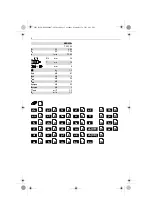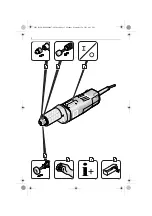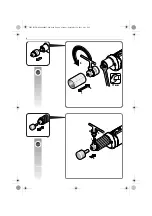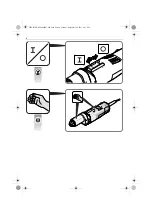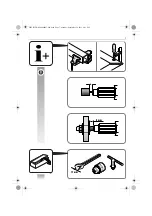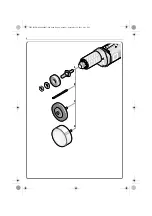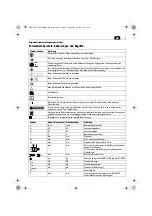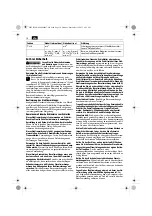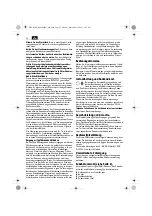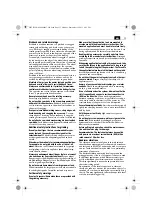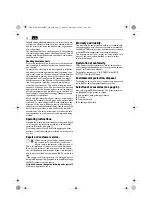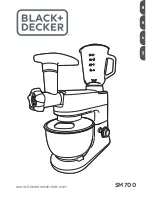
15
en
Kickback and related warnings
Kickback is a sudden reaction to a pinched or snagged
rotating wheel, backing pad, brush or any other acces-
sory. Pinching or snagging causes rapid stalling of the
rotating accessory which in turn causes the uncontrolled-
power tool to be forced in the direction opposite of the
accessory’s rotation at the point of the binding.
For example, if an abrasive wheel is snagged or pinched
by the workpiece, the edge of the wheel that is entering
into the pinch point can dig into the surface of the mate-
rial causing the wheel to climb out or kick out. The wheel
may either jump toward or away from the operator,
depending on direction of the wheel’s movement at the
point of pinching. Abrasive wheels may also break under
these conditions.
Kickback is the result of power tool misuse and/or incor-
rect operating procedures or conditions and can be
avoided by taking proper precautions as given below.
Maintain a firm grip on the power tool and position your
body and arm to allow you to resist kickback forces.
Always use auxiliary handle, if provided, for maximum
control over kickback or torque reaction during start-up.
The operator can control torque reactions or kickback
forces, if proper precautions are taken.
Never place your hand near the rotating accessory.
Accessory may kickback over your hand.
Do not position your body in the area where power tool
will move if kickback occurs.
Kickback will propel the
tool in direction opposite to the wheel’s movement at
the point of snagging.
Use special care when working corners, sharp edges, etc.
Avoid bouncing and snagging the accessory.
Corners,
sharp edges or bouncing have a tendency to snag the
rotating accessory and cause loss of control or kickback.
Do not attach a saw chain woodcarving blade or toothed
saw blade.
Such blades create frequent kickback and loss
of control over the power tool.
Additional safety instructions for grinding
Use only wheel types that are recommended for your
power tool and the specific guard designed for the
selected wheel.
Wheels for which the power tool was
not designed cannot be adequately guarded and are
unsafe.
Wheels must be used only for recommended applications.
For example: do not grind with the side of the cut-off
wheel.
Abrasive cut-off wheels are intended for periph-
eral grinding; side forces applied to these wheels may
cause them to shatter.
Always use undamaged wheel flanges that are of correct
size and shape for your selected wheel.
Proper wheel
flanges support the wheel thus reducing the possibility of
wheel breakage. Flanges for cut-off wheels may be differ-
ent from grinding wheel flanges.
Do not use worn down wheels from larger power tools.
Wheels intended for larger power tools are not suitable
for the higher speed of a smaller tool and may burst.
Further safety warnings
Use elastic spacers/liners when these are provided with
the grinding accessory.
Make sure that the application tools are mounted in
accordance with the manufacturers instructions. The
mounted application tools must be able to rotate freely.
Incorrectly mounted application tools can become loose
during operation and be thrown from the machine.
Handle grinding accessories carefully and store them
according to the manufacturer’s instructions.
Damaged
grinding accessories can develop cracks and burst during
operation.
When using application tools with a threaded insert, take
care that the thread in the application tool is long enough
to hold the spindle length of the power tool. The thread in
the application tool must match the thread on the spindle.
Incorrectly mounted application tools can loosen during
operation and cause injuries.
Do not direct the power tool against yourself, other per-
sons or animals.
Danger of injury from sharp or hot
application tools.
Beware of any concealed electric cables, gas or water
conduits.
Check the working area before commencing
work, e.g. with a metal detector.
Use a stationary extraction system, blow out ventilation
slots frequently and connect a residual current device
(RCD) on the line side.
When working metal under
extreme operating conditions, it is possible for conduc-
tive dust to settle in the interior of the power tool. The
total insulation of the power tool can be impaired.
Secure the workpiece firmly.
A work piece that is gripped
tightly in a clamping device or vice, is more secure than if
held by hand.
Hold the power tool firmly.
High reaction torque can
briefly occur.
Do not rivet or screw any name-plates or signs onto the
power tool.
If the insulation is damaged, protection
against an electric shock will be ineffective. Adhesive
labels are recommended.
Before putting into operation, check the mains connec-
tion and the mains plug for damage.
Recommendation: The tool should always be supplied
with power via a residual current device (RCD) with a
rated current of 30 mA or less.
Hand/arm vibrations
The vibration emission level given in this information
sheet has been measured in accordance with a standard-
ised test given in EN 60745 and may be used to compare
one tool with another. It may be used for a preliminary
assessment of exposure.
The declared vibration emission level represents the
main applications of the tool. However if the tool is used
for different applications, with different accessories or
poorly maintained, the vibration emission may differ.
This may significantly increase the exposure level over
the total working period.
An estimation of the level of exposure to vibration
should also take into account the times when the tool is
switched off or when it is running but not actually doing
the job. This may significantly reduce the exposure level
over the total working period.
OBJ_BUCH-0000000047-001.book Page 15 Monday, September 26, 2011 4:01 PM
Summary of Contents for 7 223 02
Page 3: ...3 4 4 6 5 6 7 7 OBJ_BUCH 0000000047 001 book Page 3 Monday September 26 2011 4 01 PM...
Page 4: ...4 1 2 3 4 2 1 17 mm 3 OBJ_BUCH 0000000047 001 book Page 4 Monday September 26 2011 4 01 PM...
Page 5: ...5 13 mm 2 1 3 4 5 6 OBJ_BUCH 0000000047 001 book Page 5 Monday September 26 2011 4 01 PM...
Page 6: ...6 OBJ_BUCH 0000000047 001 book Page 6 Monday September 26 2011 4 01 PM...
Page 7: ...7 1 a 8 mm 17 mm OBJ_BUCH 0000000047 001 book Page 7 Monday September 26 2011 4 01 PM...
Page 8: ...8 B C D A OBJ_BUCH 0000000047 001 book Page 8 Monday September 26 2011 4 01 PM...
Page 44: ...44 el H OBJ_BUCH 0000000047 001 book Page 44 Monday September 26 2011 4 01 PM...
Page 104: ...104 ru OBJ_BUCH 0000000047 001 book Page 104 Monday September 26 2011 4 01 PM...
Page 105: ...105 ru 30 EN 60745 OBJ_BUCH 0000000047 001 book Page 105 Monday September 26 2011 4 01 PM...
Page 109: ...109 uk OBJ_BUCH 0000000047 001 book Page 109 Monday September 26 2011 4 01 PM...
Page 110: ...110 uk 30 EN 60745 a 7 OBJ_BUCH 0000000047 001 book Page 110 Monday September 26 2011 4 01 PM...
Page 114: ...114 bg OBJ_BUCH 0000000047 001 book Page 114 Monday September 26 2011 4 01 PM...
Page 140: ...140 ko RCD 30 mA RCD OBJ_BUCH 0000000047 001 book Page 140 Monday September 26 2011 4 01 PM...
Page 144: ...144 th 1 OBJ_BUCH 0000000047 001 book Page 144 Monday September 26 2011 4 01 PM...
Page 149: ...149 ja OBJ_BUCH 0000000047 001 book Page 149 Monday September 26 2011 4 01 PM...
Page 151: ...151 ja 8 FEIN A B C D OBJ_BUCH 0000000047 001 book Page 151 Monday September 26 2011 4 01 PM...
Page 154: ...154 hi OBJ_BUCH 0000000047 001 book Page 154 Monday September 26 2011 4 01 PM...
Page 156: ...156 ar 30 RCD EN 60745 a 7 FI C E FEIN GmbH EGZ D 73529 Schw bisch Gm nd 8 A B C D...
Page 157: ...157 ar FI...
Page 159: ...159 ar n min P1 W P2 W U V f Hz M mm mm mm D T Fe mm kg EPTA Procedure 01 2003...


